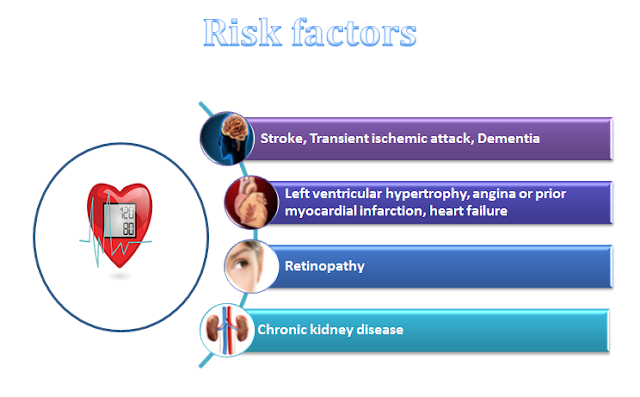Hypertension is a
heterogeneous medical condition.
With each heartbeat,
the exact amount of blood is pumped out from heart round to body to supply
oxygen and generate energy.
As the blood moves, it
pushes against the sides of the blood vessels.
The
strength of this pushing is your blood pressure.
If blood pressure is
too high, the condition is known as hypertension, which puts extra strain on
your blood vessels and your heart which may lead to heart attacks and strokes.
In most patients it
results from unknown cause known as essential or primary hypertension.
Hypertension is termed
the “silent killer” because patients with essential hypertension are
usually not having any major symptoms.
As patient
is not having any major symptoms, will not see the doctor until any major
crisis occurs and hence it remains poorly treated.
This form
of hypertension cannot be cured, it can be controlled only.
A small percentage of patients have a specific cause of their
hypertension which is known as secondary hypertension.
There are many potential secondary causes like medications, kidney
diseases, high use of contraceptives, cardiac disease.
If the cause of secondary hypertension can be identified, hypertension
in these patients potentially can be cured.
Hypertension simply
means persistently high arterial blood pressure (BP).
Blood
pressure is defined as force of
circulating blood on the wall of arteries.
Every blood pressure
reading consists of two numbers or levels. They are shown as one number on top
of the other.
The first (or top)
number is your systolic blood pressure. It is the highest level your blood
pressure reaches when your heart beats.
The second (or bottom)
number is your diastolic blood pressure. It is the lowest level your blood
pressure reaches as your heart relaxes between beats.
Based on above
definition of blood pressure, Hypertension can be defined as either a sustained Systolic Blood Pressure (SBP)
of >140 mm Hg or a sustained
Diastolic Blood Pressure (DBP)
of greater than >90 mm Hg.
It is classified into four categories for the purpose of
treatment management.
Hypertension is occasionally secondary to some distinct disease
as said above.
More than 90 percent of patients have essential hypertension,
a disorder of unknown origin affecting the blood pressure regulating mechanism.
Starting at a BP of 115/75mmHg, risk of cardiovascular disease doubles
with every 20/10-mm Hg increase.
Causes
One or more of a ‘mosaic’ of predisposing factors which
includes Positive family history, Obesity and Physical
inactivity are commonly present in patients with essential hypertension.
A family history of
hypertension increases the likelihood that an individual will develop
hypertensive disease.
The incidence of essential
hypertension is four-fold more frequent among blacks than among whites.
It occurs more often
among middle-aged males than among middle-aged females, and its increases
with age and obesity (body mass index≥30 kg/m2).
Environmental factors,
such as a stressful lifestyle, high dietary intake of sodium, and
smoking, further predispose an individual to the occurrence of
hypertension.
The patient may appear
very healthy or may have the presence of additional cardiovascular risk
factors:
Age (≥55 years for men to 65 years for
women)
Diabetes
mellitus
Dyslipidemia
(high cholesterol, total cholesterol or
triglycerides)
Tobacco
use
The primary physical
finding is elevated BP.
The diagnosis of
hypertension cannot be made based on one elevated BP measurement.
The average of two or
more measurements taken during two or more clinical encounters should be used
to diagnose hypertension.
There after, this BP
average can be used to establish a diagnosis and then to classify the stage of
hypertension.












No comments:
Post a Comment